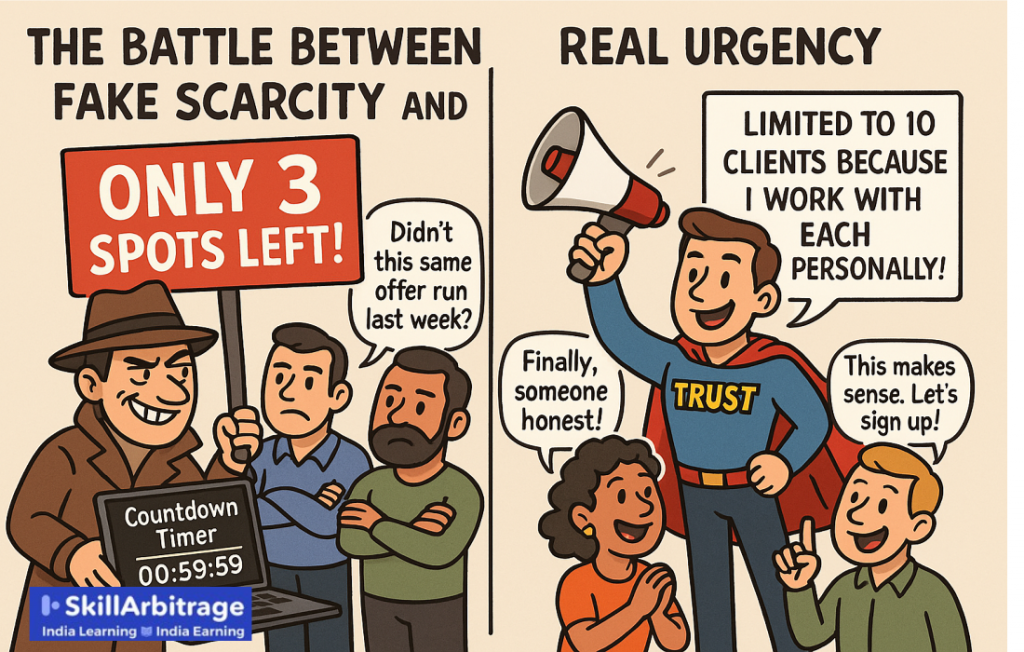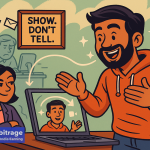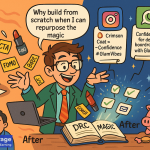This blog will show you how to create real urgency that makes people act fast without using lies, fake timers, or shady tactics that hurt your trustworthiness.
Table of Contents
Introduction
Around 5 years ago, I was sitting with my laptop open, thinking of how to create urgency on my sales page. I was staring at the words “Only 3 spots left,” thinking this would do the job, but something was just not feeling right to me.
I was not trying to lie. I just wanted people to act. I wanted momentum. But the more I looked at that line, the more it felt off. It seemed manufactured and forced. I still published it and want to hear a surprise? It did not even work that well.
That is when I realised people can feel it when an urgency is fake. Even if you keep the fake urgency subtle. And when they do, trust erodes fast, so you lose a customer forever, as now they don’t even trust what you promise.
See, creating urgency is important for a business to make sales. So, in my path to creating urgency, I started asking myself a different question. What will actually make someone want to buy now? Not because of feeling pressured, but because it actually matters to them.
And guess what happened? I found what I wanted. And now I am going to post all of that today in this one blog.
Remember, I am not talking about tactics to trick people into buying, as they erode trust in the long run. I am talking about real ways to build urgency that resonates with your audience and drives results.
If you are ready, let’s learn a step-by-step method to create urgency without using fake scarcity, but first, you must understand the real reason why urgency is even important.
Why does urgency matter in sales?
A lot of people think urgency is just about pushing people to buy fast. But that’s not true. Urgency is about creating momentum and not pressure. And if you don’t build momentum, trust me, your leads will go cold faster than you think.
See, in sales, there’s a small window when someone is interested. People don’t think about buying something for the whole day until there’s a very big need. They think they need it, then forget about it a few minutes later.
Your job is to make them buy at the exact same moment when they feel the need. If you don’t move fast and give them a reason to act now, that window closes, and once that happens, even the best offer in the world won’t help.
Because now they’ve gone back to their normal routine, forgotten the problem, and lost the emotional spark that made them interested in the first place. Let me show you how real this is, which will make you realise the importance of creating urgency:
- According to InsideSales, 50% of buyers choose the vendor that responds first. This is not due to pricing or quality, but just because they responded first. What does it prove? That they caught the customer when he “felt” the need.
- Most people don’t say “No.” They just don’t say anything and simply ignore. That’s worse, so urgency gives them a reason to make a yes or no decision instead of ghosting you forever.
- Contacting a lead within the first minute can increase conversion rates by up to 391%. This shows that if you contact them when they feel the need for the product the most, you get better sales.
- Most buyers don’t plan purchases. They feel a problem, get emotionally triggered, and that’s the moment when they buy. If you don’t catch them right then, that window shuts and it doesn’t come back.
- Harvard Business Review found that firms that follow up with leads within an hour are 7 times more likely to have meaningful conversations than those who wait longer.
- You can have a 90% discount or the best product in the world, but if there’s no reason to act now, they’ll say, “I’ll check later,” and you already know what that means.
- Even in cold email campaigns, Campaign Monitor found that emails with urgency in subject lines see up to 22% higher open rates. That’s easy, 22% more eyeballs without any extra spend.
All of this proves one simple thing that, if you don’t create urgency, people will delay their purchase decision. And history says when they delay, they disappear.
That’s why urgency is not optional. It’s not some trick to close faster. It’s the only thing that stops good leads from turning into ghosted follow-ups.
So now the real question that might be going on in your head must be, “What if I just lie and create urgency?”. That is a very big mistake, and you should immediately dump that thought.
The problem with fake urgency
I’ll be honest; I made the same mistake everyone else makes. Just slapped on a ‘limited time offer’ or ‘5 spots left’ and hoped people would panic and buy.
But trust me when I say that trick doesn’t work anymore. In fact, it backfires because people can smell fake urgency from a mile away now. Especially when you say, “Only 5 seats left,” and then keep repeating the same offer next week.
Or when you put a countdown timer on your site that magically resets every time someone visits again after a few days. That timer never seems to reach 0. We think people don’t notice these tactics, but they do.
And once that happens, the buyer stops trusting you. And when trust goes down, so does your chance of closing the sale. Think about it. If someone catches you faking urgency, won’t they also start doubting the value of your offer?
They’ll ask themselves, “If this is a lie, what else is?” And just like that, you will lose your conversions without realising that what you are doing to increase conversions is actually making it crash.
See, urgency works only when people believe it’s real. If they sense that you’re just trying to manipulate them, they’ll feel pressured, not persuaded. And no one likes being pressured into buying, especially when it’s a lie.
So, no matter how tempting it is to use fake urgency lines to try bumping up conversions, don’t do it. Because it won’t just kill the sale, but it’ll also kill your credibility. And the worst part?
You don’t even need to fake it. There are real ways to create real urgency that feel 100% authentic and actually deliver results. And that’s what I’m going to show you next. Ready?
A step-by-step method to build urgency without using fake scarcity
Before I show you the exact steps, I want you to understand that you don’t need gimmicks to get people to act. If your offer is genuinely valuable and you frame it the right way, urgency happens naturally.
Not because you scared them into buying, but because they realised waiting means missing out on something that actually matters.
See, this is not about pressure. Instead, it’s about helping them decide instantly instead of procrastinating and forgetting why they even wanted it in the first place.
So now let me show you how to build that urgency without fake timers, fake deadlines, or shady sales lines. Just real, ethical triggers that make people want to take action today.
Step 1: Make sure your offer deserves urgency
You cannot put urgency honestly and get results if your offer sucks. You need to make sure that your offer deserves urgency. It can only work if the offer feels valuable on its own, and using urgency, you are just trying to give them a reason to act instantly instead of later.
But how can you know if your offer deserves urgency? It’s simple. You just need to ask yourself these three important questions:
- “Does my offer solve a painful, real problem people already feel right now?”
This question will help you understand if people even want your offer or not. If there is pain that your product or service could solve, people will be more likely to act instantly to solve their problem; otherwise, urgency won’t make a difference.
- “Is the outcome so valuable that they’d regret missing it?”
This question will help you test if your offer actually feels like an opportunity. If someone skips your offer and does not even regret it, then it means your offer is not that valuable. So, urgency won’t make a difference.
- “If someone is already searching for a solution, would they feel lucky to find my offer?”
This question will help you judge how exciting your offer really is. If someone is actively looking for help and your offer doesn’t feel like a lucky find, then it means it’s not strong enough, and you need to improve the value first.
This matters because the truth is that you can’t build urgency on a weak foundation, just like a strong tree cannot grow without strong roots.
If the offer isn’t strong, urgency will feel fake or forced. And that will kill trust. But if the offer is genuinely good, urgency will amplify it. So if your offer is not yet good enough for urgency, fix the offer first and then move on to the next step.
If you need help in fixing the offer, read this – How to create an irresistible offer.
Step 2: Pick a real reason
See, you need to start by thinking of a reason that you will create the urgency. It cannot be a silly reason. You need to make it look authentic and real. That is what will separate urgency that works from urgency that backfires.
Your job here is to give people a clear and honest reason why your offer won’t be available later. Not just because you said so, but because it actually makes sense and looks logical.
So in this step, I am going to help you figure out how to pick a real reason that will work for your specific situation and business.
- Understand the limitation
You need to start with understanding what kind of limitation will make the most logical sense for your business. Simply ask yourself, “Why wouldn’t this offer/product/service be available forever?” and you will have the answer.
Make sure you don’t make something up. Look at the real constraints in your business, like capacity, timing, effort, seasonality, etc. Here is a simple blueprint that shows what it could be for different businesses:
- Service Business: You only take on a limited number of clients per month because you deliver everything personally. That’s your real limit. Example: a web designer, an interior consultant, a lawyer, a photographer.
- Product Business: You have limited inventory or production capacity. That’s a real reason why it can sell out. Example: handmade candles, limited edition apparel, D2C skincare products.
- Software/SaaS: You’re closing onboarding for a beta group, or the pricing is increasing from next month due to server costs. You can tie urgency to access or price. Example: CRM tool offering lifetime access for early adopters, but only till a set date.
- Offline/Local Business: You’re running a festive offer or a weekend-only deal because of inventory turnover, staffing, or event timing. Example: a restaurant offering a weekend combo or a boutique running a 3-day festive sale.
Did you understand how simple it is? You just need to find out what the real reason is for your business, due to which you cannot let the offer run forever. Now it’s time to write it in a believable way.
- Make it believable
Now that you’ve figured out the real limitation behind your offer, the next step is to say it clearly in a way that actually makes people take it seriously.
And no, you don’t need to write “HURRY! ONLY 3 LEFT!” in all caps. Yes, that stuff works when it’s true, but the reality is that people are tired of seeing it everywhere. So, you just need to state the reason calmly and clearly. Here are some examples:
- “We only have 40 jars of this batch, and once it’s sold, the next batch comes out in June.”
- “We close new projects on the 28th of each month to focus on delivery. If you want to start in May, this is the last week to book.”
- “This pricing is valid till 30th April. Next month, revised rates go live.”
- “Pre-orders close Friday night. After that, this color won’t be available again.”
Did you notice that these lines don’t scream urgency, instead, they just explain why waiting isn’t a good idea? That’s what you have to do. This way, you’re not forcing the buyer. You’re just making the reality visible.
Because when people understand the reason behind the deadline, they’re far more likely to act. Once you have your reason, it’s time you anchor it to a specific deadline.
- Anchor to a real deadline
Once you’ve written a believable reason, now it’s time to lock it in with something specific, because if you don’t attach it to a real date or condition, people will still delay. Here are four ways you can anchor your reason to a real deadline:
- A fixed date. For example: “Offer ends Sunday.”
- A count limit. For example: “Only 30 units left”
- A milestone. For example: “Price increases after the first 100 orders”
- A contextual reason. For example: “We’re closing orders before Diwali to make sure everything gets delivered on time”
Just pick the one that fits your offer naturally. And whatever you do, don’t just say “ending soon.” Be specific and say when and why. That’s how the urgency will feel real, and that’s when people will stop thinking and start acting.
So now you’ve got your reason, which is real and believable, as well as it’s anchored to a clear deadline. From here on, you don’t need to scream urgency. Instead, you just need to explain it.
Because if the buyer understands what they’ll miss by waiting, and it actually makes sense, then they won’t delay. They’ll act instantly, and that’s exactly what you want.
But that is something that they are only seeing. Won’t the urgency become much stronger if we made them emotionally feel the consequence of missing the offer?
Step 3: Show them what they will lose
This is one of the most powerful parts of building urgency because deadlines alone don’t always work. Just knowing when something ends doesn’t always make people act. What makes people act is the realisation of what they’ll lose if they don’t.
Your job now is to make the cost of procrastinating feel real. Not in a pressure-heavy way. But in a “you’re already missing out and it’s only going to get worse” kind of way. This will create emotional urgency, and emotional urgency beats logical deadlines every time.
Start by asking yourself, “What is happening in the life, business, or situation of leads while they’re still thinking?”
The answer is important because you need to understand what consequences they are facing as long as they have not bought what you provide. You’re not just selling a solution. You’re helping them escape a problem that’s already draining them.
So your first job is to understand what the delay is costing them. Here are some examples for you to understand this better:
- If you’re a marketer: Every week they wait, they’re wasting ad money on low conversions
- If you’re a fitness coach: Every week they wait, they’re falling further out of shape
- If you’re a software tool: Every week they wait, their workflow stays messy and time-consuming
- If you’re a copywriter: Every week they wait, their content keeps underperforming and leaving money on the table
Be honest with yourself while finding out what the real consequence is, and then use that pain point for your advantage because people won’t act until they understand the consequence of not acting.
Also, once you’ve written the line, don’t just hide it in your copy. Instead, put it right near your deadline from the previous step. That way, they don’t just see when to act, but they also feel why it matters to act now.
Step 4: Use real-time triggers
Even if someone is interested and willing to act fast, something might come up in their life, and they may still forget. That’s why your job is also to bring them back to something they already wanted by sending reminders.
With those reminders, you’re not forcing a decision, but you’re simply making sure they don’t miss it. So the goal now is to send reminders that feel helpful, not annoying. And to use triggers that feel personal, not automated, even if they are. But what’s the best way to do it?
- Time-based reminders
Plan 3 time-based reminders that will be sent to the leads before the deadline. In the reminders, tell them how much of the deadline is remaining, as well as give them a reason to act by showing them what they will lose if they don’t act. For example –
- 48 hours before – “Only 2 days left to claim your bonus / offer / spot”
- 24 hours before – “This closes tomorrow. If you’re in, now’s the time.”
- Final call (last 6 hours) – “Last chance. Doors close at midnight.”
But these are time-based reminders and might not be relevant for all businesses and all kinds of leads. That’s why you can also use action-based reminders. Let me explain.
- Behavior-based reminders
Instead of sending the same message to everyone, send reminders based on what the lead has done. These are called action-based reminders, and they feel more personal because they are based on their behaviour, not just the clock. For example:
- If someone added to the cart but didn’t buy – “You left this in your cart. Reminder: the bonus disappears in 24 hours.”
- If someone clicked your sales page but didn’t purchase – “You showed interest, so here’s early access again. But it closes tomorrow.”
- If someone is on your waitlist – “You’re on the early list. Priority access ends Thursday.”
These messages feel more relevant and custom, even if they’re automated, and that’s what makes people respond because it sounds like you noticed, not like you’re spamming.
Also, make sure you keep the tone helpful and not pushy while building urgency because it only works when it feels like a heads-up and not a push. So in every message, write like you’re reminding a friend and not begging like a stranger.
That tone will build trust, and when you combine it with a real deadline and a clear consequence, people will act.
Conclusion
Most people think building urgency is about shouting deadlines and forcing quick decisions. But I hope now you understand that fake scarcity doesn’t just kill sales, but it also kills trust.
I just gave you the exact, step-by-step method to create urgency that actually makes people want to act without using lies, pressure, or shady tactics. So from now on, no more fake timers, no more “limited spots” that aren’t real, and no more manipulating people into buying.
Now, it’s your turn to take everything you’ve learned here, apply it to your next launch or pitch, and watch how people stop delaying and start taking action because they want to, not because they’re scared.
FAQs
Q1. How do I build urgency for a service that’s always available?
Make it about timing or capacity. Maybe you only onboard clients at the start of each month. Maybe your schedule gets locked after 3 slots. Or maybe prices go up next quarter. The service can stay open, but the offer should evolve over time to stay urgent.
Q2. Can bonuses be used as urgency tools without sounding gimmicky?
Yes, if the bonus actually feels valuable and limited. For example: “This bonus only works if you start before the 10th, because it’s tied to a live session happening that week.” That’s real and makes sense. Don’t just say “Bonus expires” without a reason.
Q3. What if urgency makes some leads uncomfortable? Should I still use it?
Urgency that’s real does not feel like pressure. It feels like clarity. If your urgency is built around what makes sense (capacity, timing, cost), even serious leads will respect it. And if someone still feels uncomfortable, they were probably going to delay anyway.
Q4. Can I reuse the same urgency message across all platforms?
You can, but tweak the tone depending on where it’s going. An urgency message on a sales page can be more direct. On Instagram, make it feel like an update. On email, make it sound personal. Same message, different tone.
Q5. What if I genuinely want to offer something forever?
Then focus on urgency around timing instead of availability. For example: “Start now and get results by next month.” The offer stays open, but the outcome becomes time-sensitive.







 Allow notifications
Allow notifications
